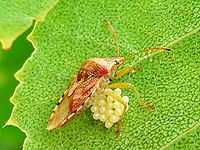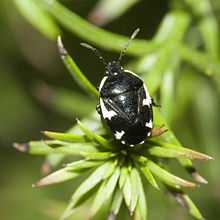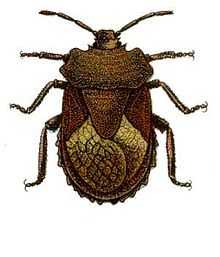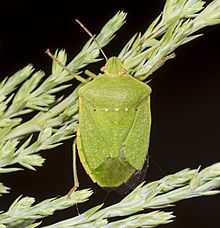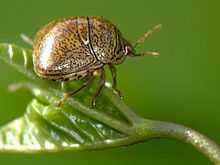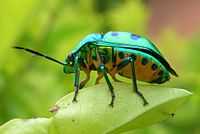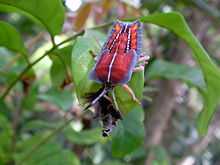Pentatomoidea
Pentatomoidea is a superfamily of insects in the Heteroptera suborder of the Hemiptera order and, as such, share a common arrangement of sucking mouthparts.[1] They are commonly referred to as shield bugs, chust bugs, and stink bugs.
There are about 7000 species under Pentatomoidea, divided under 14 to 15 families.[2][3]
Description
Pentatomoidea are characterized by a well developed scutellum (the hardened extension of the thorax over the abdomen). It can be triangular to semi-elliptical in shape.[3] Pentatomoidea usually have antennae with five segments. The tarsi usually have two or three segments.[4]
Shield bugs have glands in their thorax between the first and second pair of legs which produce a foul smelling liquid. This liquid is used defensively to deter potential predators and is sometimes released when the bugs are handled carelessly.
The nymphs, similar to adults except smaller and without wings, also have stink glands.
The nymphs and adults have piercing mouthparts, which most use to suck sap from plants, although some eat other insects. When they group in large numbers, they can become significant pests.
Species that resemble pentatomoids are found in the superfamily Coreoidea.
Families
The following families are classified under Pentatomoidea:[5]
- Acanthosomatidae Signoret, 1863 – Known as shield bugs. Contains 46 genera and 184 species found worldwide.[6]
- Canopidae McAtee & Malloch, 1928 – Found strictly in the Neotropical ecozone.[7]
- Corimelaenidae Uhler, 1872 includes the former family, subfamily Thyreocorinae Amyot & Serville, 1843 – Known as ebony bugs, they are small oval bugs that are a shiny black.[8]
- Cydnidae Billberg, 1820 – Known as burrowing bugs, it contains 120 genera and about 765 species worldwide.
- Dinidoridae Stål, 1867 – Found in tropical Asia, Africa, Australia, and South America. It is composed of 16 genera and about 65 species.[3]
- Lestoniidae China, 1955 – Small round bugs which bear a resemblance to tortoise beetles (Chrysomelidae). It is composed only of one genus and two species, it is endemic to Australia.[9]
- Megarididae McAtee & Malloch, 1928 – Contains only one genus (Megaris) and 16 species. They are small globular bugs occurring in Central America.[10]
- Parastrachiidae Oshanin, 1922 – Bright red and black bugs exhibiting maternal care of eggs, they are composed of one genus and two Asian and Estern Palearctic species.
- Pentatomidae Leach, 1815 – Known as stink bugs, it is the largest family in Pentatomoidea. It contains around 900 genera and over 4700 species.
- Phloeidae – Large mottled brown and flattened bugs found strictly in the Neotropical ecozone.. It is composed on only 2 genera and 3 species. They are known to exhibit strong maternal care.[7]
- Plataspididae – Found in Asia, particularly eastern Asia, although a few species of Coptosoma occur in the Palearctic. They are round plant-feeding bugs. It has about 59 genera and 560 species.
- Scutelleridae – Known as jewel bugs or shield-backed bugs. Composed of 81 genera and about 450 species.
- Tessaratomidae – Known as giant shield bugs because they are usually relatively large. Has about 55 genera and 240 species worldwide (mainly in the Old World tropics).[2][3][12]
- Thaumastellidae – Small bugs usually found under rocks in tropical Africa and the Middle East. It contains only one genus and three species. There is some debate to their inclusion within Pentatomoidea.[13]
- Urostylididae – Contains about 11 genera and 170 species. They are found in Southern and Eastern Asia. (including Korea).
| Example species of the families under Pentatomoidea |
|---|
| Scutelleridae: The lychee shield bug, Chrysocoris stolli, a jewel bug. |
|
Phylogeny
The morphological unweighted tree of Pentatomoidea after Grazia et al. (2008).[14][15]
See also
References
- ↑ "Hemiptera: bugs, aphids and cicadas". CSIRO. Retrieved 2007-05-08.
- ↑ 2.0 2.1 Cedric Gillott (1995). Entomology. Springer. p. 604. ISBN 978-0-306-44967-3.
- ↑ 3.0 3.1 3.2 3.3 G. Cassis, Australia. Bureau of Flora and Fauna, & Gordon F. Gross (2002). Zoological catalogue of Australia: Hemiptera: Heteroptera (Pentatomomorpha). Csiro Publishing. p. 353. ISBN 978-0-643-06875-9.
- ↑ T. N. Ananthakrishnan (2004). General and applied entomology. Tata McGraw-Hill Education. p. 370. ISBN 978-0-07-043435-6.
- ↑ David A. Rider (October 20, 2009). "Classification". Department of Entomology, North Dakota State University. Retrieved April 29, 2011.
- ↑ Faúndez, E. I. 2009. Contribution to the knowledge of the genus Acrophyma Bergroth, 1917 (Hemiptera: Heteroptera: Acanthosomatidae). Zootaxa. 2137: 57–65
- ↑ 7.0 7.1 P220 Randall T. Schuh, James Alexander Slater, True bugs of the world (Hemiptera:Heteroptera): classification and natural history, Cornell University Press, 1995, ISBN 0-8014-2066-0
- ↑ Mike Boone (September 11, 2004). "Family Thyreocoridae – Ebony Bugs". BugGuide, Iowa State University. Retrieved April 29, 2011.
- ↑ P136 Christopher G. Morris Academic Press dictionary of science and technology, Gulf Professional Publishing, 1992, ISBN 0-12-200400-0
- ↑ www.discoverlife.org
- ↑ James T. Costa (2006), The other insect societies; Belknap Press Series Harvard University Press, p.311, ISBN 0-674-02163-0
- ↑ P353 Zoological Catalogue of Australia
- ↑ Dimitri Forero (March 13, 2009). "Pentatomoidea". Tree of Life web project. Retrieved April 28, 2011.
- ↑ Jocelia Grazia, Randall T. Schuhb, & Ward C. Wheeler (2008). "Phylogenetic relationships of family groups in Pentatomoidea based on morphology and DNA sequences (Insecta: Heteroptera)". Cladistics (Wiley-Blackwell) 24: 932–976. doi:10.1111/j.1096-0031.2008.00224.x. Retrieved April 27, 2011.
External links
|
|---|
| | | | | | | | |
|---|
| |
- Ceratocombidae
- Dipsocoridae
- Hypsipterygidae
- Schizopteridae
- Stemmocryptidae
|
|---|
| | | |
|---|
| | Gerroidea | |
|---|
| | |
|---|
| Hydrometroidea | |
|---|
| |
- Madeoveliidae
- Mesoveliidae
|
|---|
|
|---|
| | | | | |
|---|
| Nepoidea | |
|---|
| Ochteroidea | |
|---|
| Aphelocheiroidea |
- Aphelocheiridae
- Potamocoridae
|
|---|
| | |
|---|
| | |
|---|
| Pleoidea | |
|---|
|
|---|
| | | | |
|---|
| | |
|---|
| |
|
|
|
